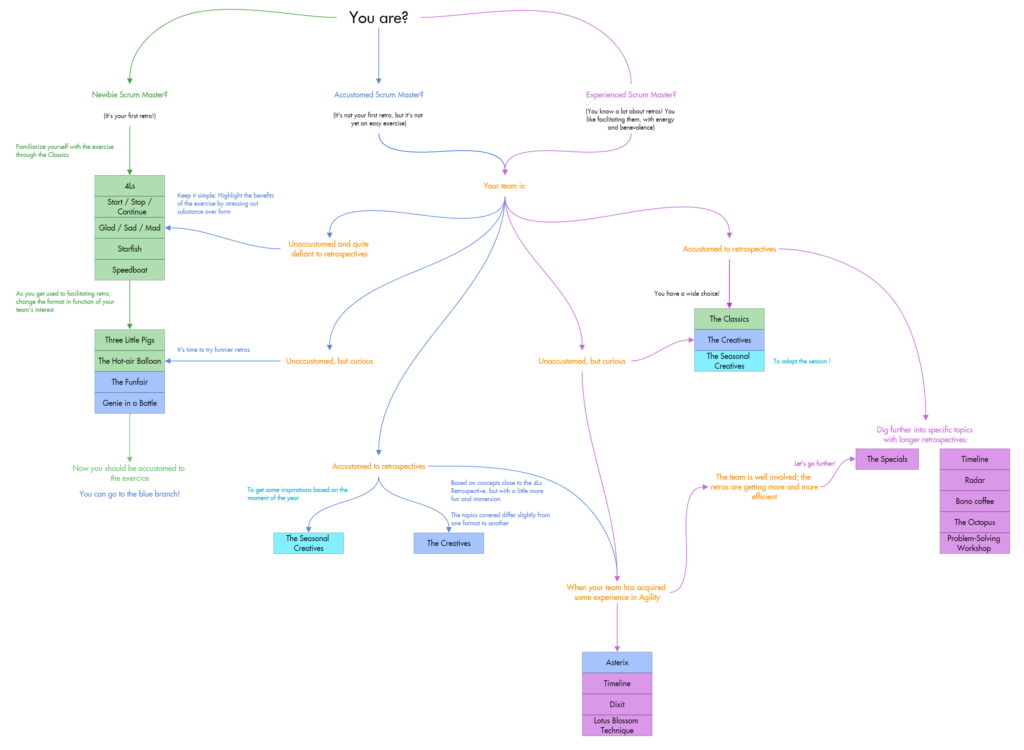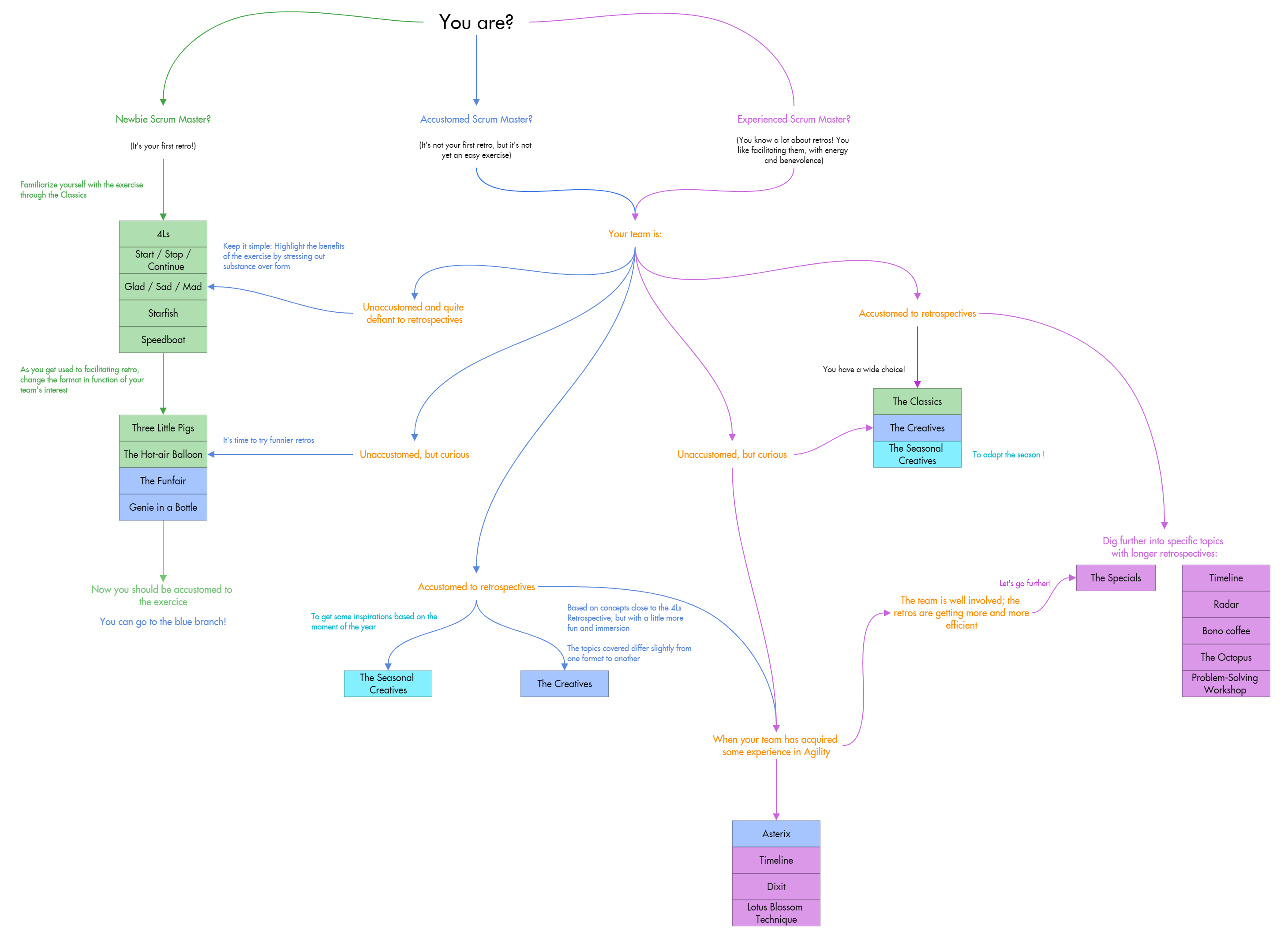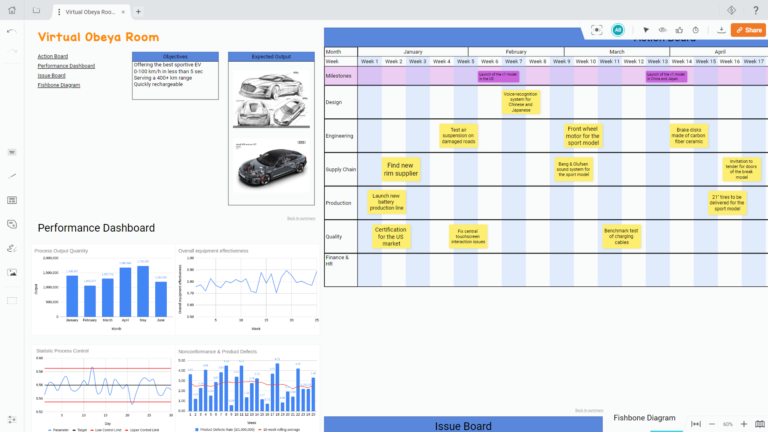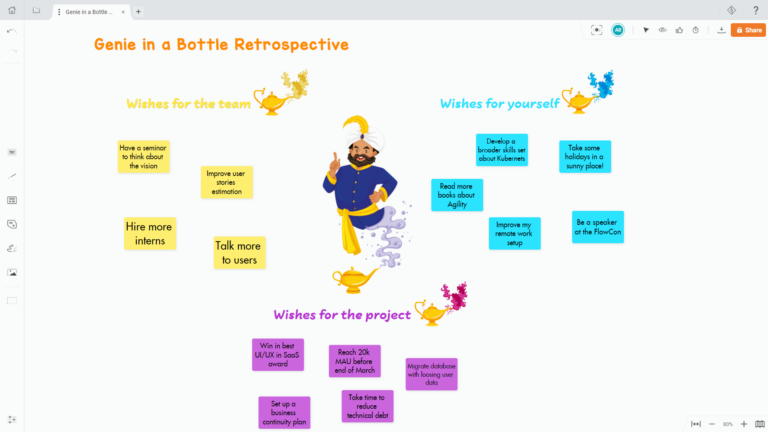Whether you are a beginner or an experienced Scrum Master, we know how challenging it is to keep teams involved as the retrospective ceremonies come one after another. It is, therefore, essential to adapt retrospective formats to break the routine and stimulate team members’ reflection.
This is why we – Jordan Vergnaud Di Sante, Christophe Servy, and Alexandre Gay, all 3 Scrum Masters and Agile Coaches at Inetum – have combined our respective experiences to help you, first of all, to acquire a better overview of the range of existing retrospective formats and their specificities and, secondly, to choose the theme best suited to your context.
1. What is the retrospective ceremony for?
Sometimes felt as a waste of time or as a redundant and tedious meeting, the retrospective ceremony is nevertheless an essential ritual of Agility and often an infallible indicator of the successful adoption of its practices.
The retrospective ceremony is part of the continuous improvement effort advocated by Agility. At regular intervals, at the end of each sprint, it forces the team to step back from the conduct of operations, question its possible dysfunctions, and highlight its successes.
2. Why is it necessary to vary retrospective formats?
A sprint generally lasts two to four weeks, and the retrospective takes place at the end of each sprint. A calendar year can theoretically have up to 26 retrospectives. If the format remains the same each time, the team can quickly tire and lose excitement in this exercise.
Although the purpose of each retrospective ceremony remains the same – identify the problems encountered by the team to optimize its functioning in a logic of continuous improvement –, it is essential, as Scrum Master, to vary the themes and formats to stimulate the interest of his team and to obtain the best possible involvement.
In addition, by choosing the proper format, the Scrum Master can direct the team’s thinking toward a particular theme, such as its practices, future risks, or recognition of other team member’s contributions. And much more! This change of perspective contributes to challenging the team in its way of seeing things and digging into the problems and the positive points from different angles.
Fortunately, the Agile community is creative and prolific. In addition to the classic retrospective formats, there is a wide variety of formats with original themes that adapt to seasons, the news, or your team’s interests.
“If a team doesn’t have time to run one retrospective, they must run two!”
An anon Agile master.
3. What are the different categories of retrospective formats?
To save you time and help you find the ideal retrospective format for the next sprint ceremony, we have drawn up an extensive overview of existing retrospectives known on the internet, adaptations of known themes, and creations on our part. We have classified them into 4 categories: Classics, Creatives, Seasonal Creatives, and Specials.
| Format | Description | Duration | Complexité |
| The Classics | |||
| Start-Stop-Continue Retrospective | 3 axes of reflection: – Start (what to start doing) – Stop (what you need to stop doing) – Continue (what to continue doing) | Short | Easy |
| Speedboat Retrospective | 4 axes of reflection: – What drives us – What holds us back – The risks to come – The objective | Short | Easy |
| Three Little Pigs Retrospective | 3 axes of reflection to question the solidity of the team/project’s practices: – Unstable – To consolidate – Solid | Short | Easy |
| Glad-Sad-Mad Retrospective | Reflection on oneself with 3 axes. What made us: – Happy – Sad – Irritated | Short | Easy |
| 4Ls Retrospective | Reflection on the resources people need and their desires: – Liked (what I liked) – Learned (what I learned) – Lacked (what I missed) – Longed (what I wanted) | Short | Easy |
| Starfish Retrospective | The Start/Stop/Continue Retrospective with 2 additional axes: – More than – Fewer – Start to – Stop doing – Continue to | Medium | Medium |
| Matrix Retrospective | A 4Ls Retrospective revisited: – Happy – Unhappy – Thanks – Idea | Short | Easy |
| The Hot-air Balloon Retrospective | 4 axes of reflection in order to determine: – The elements that push the team forward – Obstacles that pull the team down – The storm looming on the horizon – The levers to avoid the next bad weather | Short | Easy |
| The Creatives | |||
| The Funfair Retrospective | 4 axes of reflection: – What requires a lot of effort for little gain? – What gives us visibility and motivates us? – What is painful? – What makes us happy? | Short | Easy |
| Genie in a Bottle Retrospective | 3 axes of reflection: – Wishes to the team – Wishes to you – Wishes for the project | Short | Easy |
| The Breaking Bad Retrospective | 6 axes to reflect from various angles: – What slows you down? – What helped you? – What to avoid? what is bad? – The really good idea – The false good Idea – What must we continue to achieve the objective?(Present the team’s objective(s) before the retrospective) | Medium | Difficult |
| The Simpsons Retrospective | 5 areas of reflection focused on the team: – What didn’t quite go as planned in the last iteration? – What’s really good? What do we need to continue? – Who did a good job in the last iteration? Who do we want to congratulate? – What should we avoid? What should we move away from? What should we avoid doing in the next iteration? – What makes us laugh as a team? What makes our job enjoyable? | Medium | Difficult |
| The Judo Tokyo Retrospective | 4 axes of reflection with a sports angle and a notion of obstacles: – The medal: What is the objective? – What slows you down? – What was the biggest obstacle to getting the medal? – What allows you to be stronger? | Short | Easy |
| The Asterix Retrospective | 6 axes of reflection to make an exhaustive assessment: – What did we do that wasn’t very fine, a bit gross? – What good ideas did we have during this sprint? – What annoys us or irritates us? – What slows us down? – What makes us stronger or moves us forward? – What risks for the future? | Medium | Medium |
| The Money Heist Retrospective | 4 axes of reflection: – Who supports you during challenging events. What do they bring you? – What is good in your project/team? What do you need to keep? – What is wrong with your project/team? What must you avoid or be subject to defeat the professor’s plan? – What would you ask the professor? What are your doubts? your fears? | Medium | Medium |
| The Kaamelott Retrospective | The 4Ls Retrospective was revisited with role play to make the session more fun. The 4 axes are: – Good points – Questions and doubts – Improvement points – New ideas | Medium | Easy |
| The Star Wars Retrospective | 3 axes of reflection: – The risks – What makes you move forward – What slows down | Short | Easy |
| The Lord of the Rings Retrospective | 6 areas of reflection with an introductory text to get you in the character’s mindset: – What do you need to protect? what is nice? – The false good idea – What to avoid? what is bad? – What helped you? – Which might make us go faster next time? – What slows you down? | Long | Difficult |
| The Vikings Retrospective | 4 axes of reflection: – Who supports you? What do they bring you? – What is bad? What should you avoid? – Question for the diviner: What are your doubts and fears? – What is good? what you should keep? | Medium | Medium |
| The Match Replay Retrospective | A Sprint rating with 3 axes of reflection: – What are the areas for improvement? – What allows you to move forward – What makes the team slow down? | Short | Easy |
| Kudos tree | Thank team members, and show gratitude. | Short | Easy |
| Tweet my Sprint | 7 axes of reflection: – Happy: What is good? – Thanks: Thank team members. – Fast: What made it possible to go quickly? – Improve: What is the feasible improvement axis for the next Sprint? – Sad: A bad feeling, something that went wrong. – Slow: Something that slows down the workflow. – Risk: A future risk. | Long | Difficult |
| The Seasonal Creatives | |||
| The Zombie Retrospective (Halloween) | 4 axes of reflection plus a categorization of the subjects to be explored and a questioning of the actions carried out and to be carried out. Retrospective with role play to get in the mood and move from one room to another: – What risks do you identify for the next iterations? – What was the “medical kit” that helped you in the iteration? – What was the poison that made you suffer during the iteration? – Who are you calling? To ask what? | Long | Difficult |
| The Harry Potter Retrospective (Halloween) | 6 axes of reflection: – What successes can we celebrate? – What should we focus our attention on? – What guides us on our way? – What would energize or motivate us? – What paralyzed us? What stopped us in our progress. – What risks can we predict? | Medium | Difficult |
| The Holiday Road Retrospective | 4 axes of reflection: – What slows us down? – What annoys us? – What motivates us? What drives us forward? – Great, well done | Short | Easy |
| The New Eve Retrospective | 3 axes of reflection, out of which 2 to make an assessment of the past year and 1 to project on the new year: – What was good? – What was worse? – Good resolution: what should we do? With 2 questions at the beginning of the session to know the physical and mental state of the participants and their confidence in the project at the beginning of the year. | Short | Easy |
| The Christmas Retrospective | 3 axes around the theme of Christmas: – Threats and dangers. What could have prevented us from delivering our gifts or receiving them? What were the irritants that annoyed us? – What makes you a Santa Claus? The gifts you brought and/or received. – Our engines. What pulled us forward? Our allies. What helped us to deliver or receive our gifts? | Short | Easy |
| The Back to School Retrospective | 3 axes to do the cleaning: – To throw away – To reuse – To buy | Short | Easy |
| The Specials | |||
| Timeline Retrospective | Assessment over a long period of time. Remember important events during this period, the key points. | Medium | Medium |
| Radar | Self-assessment on 12 criteria (Motivation, Cohesion, Internal Communication, Organization, External Relations, Skills, Objectives, Means, Management of Obstacles, Performances, Meetings, and Agility) related to the functioning of the team. It can serve as an indicator for the team. | Long | Medium |
| Dixit | The goal is to show empathy and trigger discussions on unexpected subjects. | Medium | Medium |
| Bono coffee | Find solutions to problems with a workshop that combines Lean Coffee and Bono’s hats. | Long | Difficult |
| The Octopus Retrospective | Make a more guided assessment under different axes. Particularly adapted in a scaled agility context for a multi-team retrospective. The 8 axes are: – Delivery (process, DevOps, etc.) – Meetings (procedure and content of meetings and ceremonies themselves) – Organization – Communication – Tools – Reporting – Framing – Quality (of what is produced) | Long | Difficult |
| The Helping Hands | Workshop to review each team member’s roles and responsibilities, leading to a reflection about how to set up mutual aid between the team members. | Long | Difficult |
| Problem-Solving Workshop | Find solutions to problems with a workshop that combines the Liberating Structures “What, So what, Now what” and the “5 whys”: – What: description of the problem – So What: Impact of the problem – 5 Whys: Search for the root causes – Prioritization of actions related to the root cause (effort/benefit matrix) – Means of verifying problem resolution: Acceptance criteria | Long | Difficult |
| Lotus Blossom Technique | It allows you to address targeted issues and find ideas to solve them. | Medium | Medium |
4. How do I choose the retrospective format best suited to my context?
As we are aware that the range of possibilities is vast and that it is not always easy to make sure to make the right choice, we have prepared a decision tree that will help you select the most suitable format for your context, that is to say, the one that will have the best chance of stimulating reflection within your team.
By context, we mean your maturity in using retrospectives as a Scrum Master and the maturity of the team participating in the ceremony.

5. Some tips and tricks to make your retrospective ceremony a success
First, as Scrum Master (or “Servant Leader”), you must ensure that each group member adopts a posture conducive to discussion. Thus, it is crucial to promote kindness and transparency and to maintain, in all circumstances, an active listening posture.
“Regardless of what we discover, we understand and truly believe that everyone did the best job they could, given what they knew at the time, their skills and abilities, the resources available, and the situation at hand.”
Norman L. Kerth, Project Retrospectives: A Handbook for Team Reviews.
Each team member should feel safe when they speak, whatever their personality, seniority, or anteriority. It requires genuine humility from everyone on the team.
In addition to identifying malfunctions, you should highlight successes and thank team members who have helped the team do its work and achieve its goals. Indeed, identifying what works satisfactorily and thinking about the causes of this good functioning contribute significantly to maintaining and strengthening good practices.
5.1 Some specific tips for hosting your retrospective ceremony remotely
We are placing ourselves in a situation where all the participants are remote and not in a hybrid case where some of the participants are co-located, a configuration which, in our experience, is not ideal for running the workshop.
The rules we recommend are relatively classic:
- Each participant must have a camera and activate it; it is essential to be able to read the facial expression of the participants;
- Participants should not carry out other activities at the same time; this affects the quality of listening and discussion;
In addition, we recommend starting the ceremony with an icebreaker to bring a playful side and conclude with a ROTI to collect the participants’ feedback concerning the workshop’s perceived effectiveness.
5.2 Some specific tips for hosting your face-to-face retrospective ceremony
Our tips aim to make the retrospective ceremony more informal than other ceremonies.
First, regarding the location, we recommend conducting the ceremony in a warmer place than a conventional meeting room, for example, an area with sofas, armchairs, etc. If this is not possible, you can conduct the retrospective outside the company, for instance, over a meal or a coffee.
A retrospective is also an opportunity to relax, take the time to discuss non-professional topics, and celebrate the Sprint. As such, plan drinks, something to snack on, and, why not, some music to relax the atmosphere.
Of course, the computers must remain closed and the telephones in the pocket so the participants can fully connect and make the most of the present moment.
And finally, remember to start the ceremony with an Ice Breaker to bring a playful side and conclude it with a ROTI to collect the participants’ feedback on the perceived effectiveness of the workshop.







